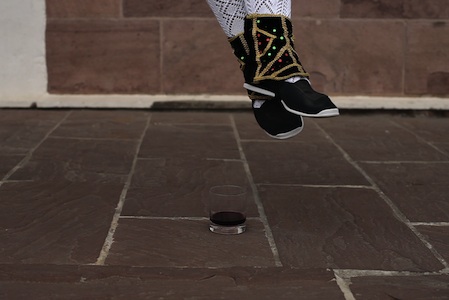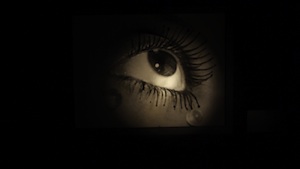A beguiling low-key charmer that is by turns (many of them) willfully self-indulgent and utterly magnanimous, In Search of Emak Bakia by Pamplona-based director Oskar Alegria is enjoying an unexpected destiny as fortuitous as its riddled-by-chance methodology. Nominally inspired by the search for the eponymous house in which Man Ray shot his 1927 avant-garde cine-poem, Alegria’s imaginative rejoinder to Ray’s cinema of contingency is making its North American premiere—after successful stops in Buenos Aires and Edinburgh—at none other than the elusively prestigious Telluride Film Festival. Known for its selectively (and secretly) curated program that includes Cannes hits, restored silents, pre-Toronto breakouts, and several underserved gems that might otherwise remain off the cinematic map, Telluride thrives on the anticipated disclosure of its annual line-up. The unorthodox line of inquiry established by In Search of Emak Bakia, originating from the director’s peregrinations on the Basque coast, extends by surreal logic to the Rocky Mountains, where the notion of letting chance be your guide may prove the best way of navigating a festival that, however condensed, resists being reduced to the sum of its parts.
The peculiar Basque phrase, we come to learn, translates as ‘leave me alone,’ a precondition for Ray’s experiment as well as a metaphor for Alegria’s artistic process: less stubborn hermeticism than a plea for aesthetic autonomy, to roam where one may.
The film begins as a seemingly earnest consideration of Ray’s bagatelle of a film, and morphs like an exquisite corpse into a search, without an explicit motive, for the house he inhabited while filming, curiously named Emak Bakia. The peculiar Basque phrase, we come to learn, translates as “leave me alone,” a precondition for Ray’s experiment as well as a metaphor for Alegria’s artistic process: less stubborn hermeticism than a plea for aesthetic autonomy, to roam where one may. And roam Alegria does, both literally tracking his footsteps on pavement and his eyes on house names, and imaginatively, by allowing the obstacles of his search to yield up less conspicuous but still rich connections and flâneur-bred associations. The conceit would appear too minor or obtuse, an act of nombrilisme, for a feature documentary, and yet the process becomes compelling for the way it channels distraction as an alternate form of attention.
Man Ray becomes a pretext if not a cipher for Alegria’s pursuit into alternately spectral and material realms, as the camera alights on a plastic glove buoyed by the breeze (and its chance encounter with a napkin); Basque nomenclature, a clown’s gravestone, an unsigned postcard bearing an inquisitive “Are you behaving yourself?”—a litany of digressions that retraces, as if following the tracks of a an impulsive hare, random encounters back to unsuspecting origins. The sense of free-association and causality is overdetermined, occasionally verging on parody: Witness the unintentionally poker-faced testimonials from musicians, surrealism scholars, penmanship experts—while yielding a deeper, even melancholy consideration of past lives, lost words, dead languages and cultural identity. It is to this enigma, particular to and definitive of Basque culture, that the film owes its sense of gravity. Where do old words go to die? How does language—semantic and phonetic–function as an historical narrative? Alegria seems most invested in these questions, and the search for a house becomes a search for the essence of an expression. In Alegria’s wayward semiotics, taking no sign for granted entails opening up the signified for reinvigorated inspection. Plumbing the depths always begins with scratching the surface.
If the intent of Alegria’s campaign feels as elusive as filming a dreaming pig, as Ray did before him, he proceeds to include such an experiment, the writhing swine flush with reverie. And if finally locating the actual house (with the aid of a little architectural evidence) is something of an anti-climax to the unfolding mystery, it is what the house contains that proves the unexpected destination of Alegria’s space odyssey. Where Ray added salt to the negative to lend an element of hasard to his film, Alegria delights in the act of recording seemingly implausible trajectories. An adorable, aged Romanian princess who is a National table tennis champion, cousin to Nabokov, and remembers the house’s pet Saint Bernard as well as the giant storm that destroyed its roof; a World War; a French worker’s union playing billiards; the haunted sound of stained glass and wooden banisters: These are the things of unofficial legend uncovered by a film whose gaze is at once lucid and filtered through half-lidded eyes.
Invoking a host of allusions and illusions, In Search of Emak Bakia revels in a sense of playful paradox, recalling some of Rebecca Solnit’s wanderlust, Corneliu Porumboiu’s etymological ethics, and in particular the lesson of Miroslav Holub’s poem about Hungarian soldiers lost in the Alps, facing imminent icy death, only to be lead to safety after finding a map which, upon reflection, is a map of the Pyrenees. The seed for getting lost, says Alegria, came from this “ancient Basque expression Emak Bakia—which is in disuse now, the younger generation says ‘Utzi Pakean’—and a house, and an epitaph, bearing that expression. These were clues, and this for me was a good enough starting point for a film about searching and the gift of chance.” At Telluride, one might stray into the unexpected territory of Alegria’s ‘little’ film and find it unusually welcoming. Consider it another instance of Basque pioneers leaving their mark on the American West.





